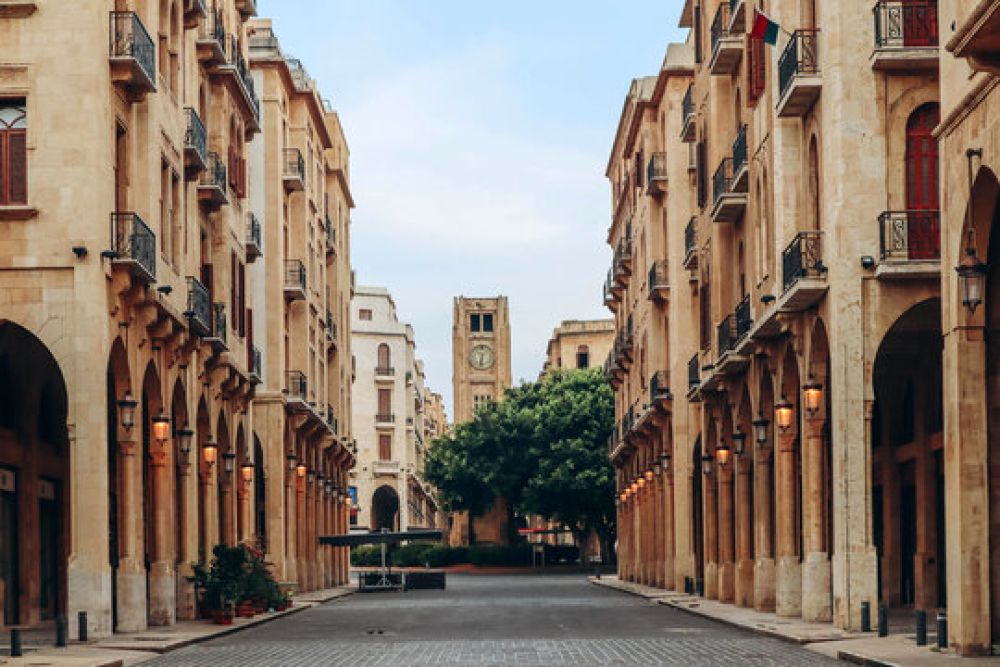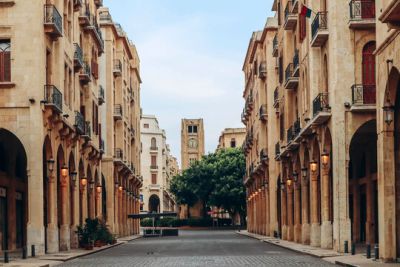

Beirut Souks is a vibrant, commercial hub that mixes the old charm with modern retail. It encompasses a vast area of stores, restaurants, and entertainment facilities in the heart of the Beirut Central District. When exploring Beirut Souks, visitors will find a compelling fusion of Lebanese tradition with contemporary culture, displayed through its architecture and diverse selection of shops. Whether hunting for high-end fashion labels, wanting to indulge in local and international cuisine, or seeking family activities at the entertainment center, this souk caters to all. The place thrives with life during the day and offers a pleasant atmosphere for evening strolls. It's an ideal location for people-watching and immersing oneself in the liveliness of Beirut's social scene.
The Roman Baths in Beirut are a testament to the city’s ancient history and a remarkable site to visit. Unearthed in the late 1960s during the construction phase of the Al-Majidiya Mosque, the baths offer an insightful window into the leisure practices of ancient Roman times. As you walk through the ruins, you can marvel at the sophisticated engineering that the Romans employed, including an ingenious hypocaust system employed to heat the floors and walls. The well-preserved fragments of the site reveal spaces that were used for cold, warm, and steam baths, reflecting a complex social ritual that was integral to Roman urban life. Visitors can take a guided tour to better understand the historical context or enjoy the serenity of the adjacent public garden for a quiet retreat from the bustling city around it.
The Mohammad Al-Amin Mosque stands as a prominent landmark in the Beirut skyline with its dazzling blue dome and four minarets. Built in a style reminiscent of the Ottomans, this mosque offers a tranquil space for reflection and prayer amidst the bustling city. Both Muslims and non-Muslim visitors are welcome to explore its ornate interior filled with intricate Islamic calligraphy and a large, splendid chandelier that commands attention. The mosque's open courtyard and the peaceful ambiance within offer a spiritual respite. This site is not only a place of worship but also a symbol of the city's religious diversity and cultural heritage. When visiting, it is essential to dress modestly and observe silence, to respect the sanctity of the mosque.
Nejmeh Square, or Place de l'Étoile, is at the core of Beirut's historical and commercial center, marked by its iconic Art Deco architecture and radiant atmosphere. At the heart of the square stands the famous Lebanese Parliament building, surrounded by a range of cafes and restaurants where one can experience authentic Lebanese hospitality. The square's radial streets ooze charm and history, guiding visitors on a walk through time as they pass by finely restored buildings from the French Mandate period. During your visit, make sure to look upward to admire the beautiful balconies and facades that tell stories of Beirut's rich past. The pedestrian-friendly area is often filled with music, making it a joyful place to unwind and experience the local culture.
The Beirut Art Center is an essential destination for contemporary arts, providing innovative platforms for creative expressions in the region. It features an ever-changing roster of exhibitions, film screenings, and performances from international and local artists. The center aims to engage audiences by presenting thought-provoking art that addresses both regional concerns and universal subjects. Art enthusiasts and novices alike are welcomed into a minimalist space that invites contemplation and discourse. For those interested in the latest in the art scene, discussions, and workshops offer a deeper dive into the works displayed. A visit here is a journey through the dynamic and diverse voices of contemporary artists working in a range of media.
Saint George Greek Orthodox Cathedral is a spiritual beacon for the city's orthodox community and is steeped in history and legacy. The cathedral's foundation dates back to the 6th century, although the current structure has been rebuilt several times due to earthquakes and war damages. The interior of Saint George is adorned with significant iconography and elaborate religious art. Notably, it also houses a crypt museum that displays artifacts and remnants of earlier churches, unveiling layers of Beirut's past civilizations. Tourists are drawn to the cathedral for both its historical significance and architectural beauty; it offers an enlightened glimpse into the Eastern Orthodox faith and tradition. Visitors should ensure to dress respectfully when entering the religious site.
A trendy and upscale waterfront promenade, Zaitunay Bay offers visitors a chance to bask in Mediterranean bliss while enjoying views of luxury yachts and the sparkling sea. It's home to an array of high-end eateries, outdoor cafes, and boutique shops, making it the perfect spot for a leisurely lunch or a relaxing evening. The marina provides ideal scenery for a casual stroll or a longer jog by the sea. For those with a taste for the finer things, Zaitunay Bay allows for people-watching and possibly celebrity sightings, as it's a known hotspot for the affluent. Moreover, boat tour opportunities are available, allowing you to enjoy Beirut's coastline from the water.
The National Museum of Beirut is a compelling destination for history buffs and cultural enthusiasts. It acts as a guardian of Lebanon's rich archaeological heritage, shedding light on its multifaceted past from prehistory to the medieval Mamluk period. As Lebanon's principal museum of archaeology, the museum houses an extensive collection of artifacts including sculptures, mosaics, pottery, and jewelry, each telling a story of civilizations that once thrived in this region. Visitors will be impressed by the well-curated exhibits which take them on a narrative through the centuries. The museum also has a poignant history, with conservation efforts during the Lebanese civil war to protect its treasures, adding an extra layer to its venerable atmosphere.
Gemmayzeh Street, known for its bohemian flair, is a cultural hub teeming with art galleries, vintage boutiques, and a myriad of bars and cafes. The street epitomizes Beirut's nightlife and is a popular destination for both locals and tourists. By day, visitors can explore unique shops and enjoy the local art scene, while by night, the street transforms into a lively party atmosphere with music pouring out from various establishments. A stroll along Gemmayzeh Street is an immersive experience, reflecting the youthful and creative spirit of Beirut. It's the ideal place to interact with the locals, taste innovative cocktails, and perhaps catch live music performances or impromptu street art displays.
To truly appreciate the layers of history and culture in Beirut, a guided walking tour is the ideal activity. Knowledgeable guides take visitors through the city's most historic neighborhoods, providing insights into Beirut's complex past and vibrant present. The tours often cover landmarks such as Martyrs' Square, the reconstructed downtown district, the Beirut Souks, and hidden gems that only locals know about. Participants learn not only about the architectural and historical aspects of the city but also get a sense of the everyday life of its inhabitants. It's an enlightening way to connect with the city and understand the events that have shaped its current identity.
